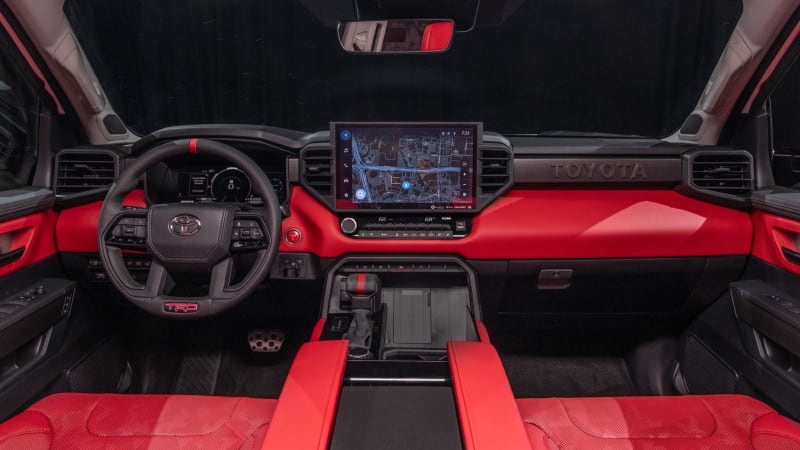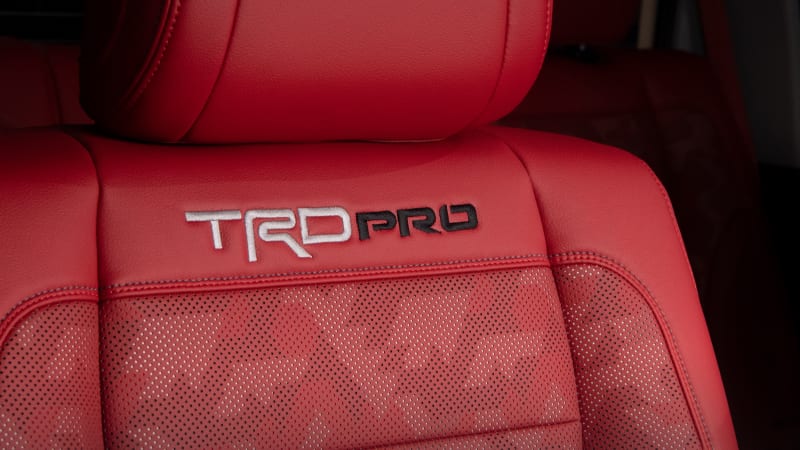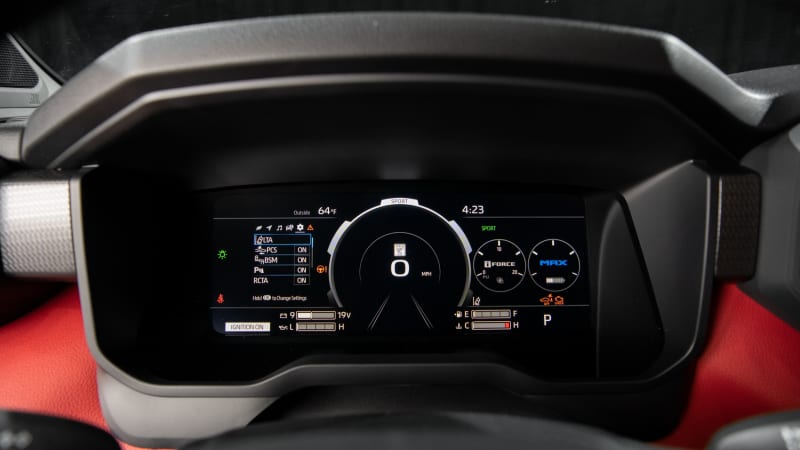In the ever-escalating truck wars in America, where the fullsize pickup outsells every other type of vehicle, 15 years isn’t just a long time. It’s practically an eternity. But that’s how long Toyota kept its second-generation Tundra on sale, having debuted all the way back in February of 2006 for the 2007 model year. Back then, the Tundra’s 5.7-liter V8 engine’s 381 horsepower and 401 pound-feet of torque sounded impressive, the six-speed automatic was state of the art and its 10,000-pound tow rating was competitive. Today? Not so much.
It’s about time, then, for a thorough redesign. And the 2022 Toyota Tundra is exactly that — there isn’t a single nut or bolt that carries over from the outgoing truck. In place of the old truck’s V8 engine is a new twin-turbocharged 3.5-liter V6, optionally assisted by an electrified hybrid variant that’s both more powerful and more efficient. In standard form, 389 horsepower and 479 pound-feet of torque are shuttled through a 10-speed automatic to either the rear wheels or all four.
The real headline grabber, though, is the optional I-Force Max powertrain. Boosted by an electric motor that sits nestled in the transmission bell-housing behind the engine and is wired to a 288-volt nickel-metal hydride battery pack under the rear seat, a total of 437 hp (at 5,200 rpm) and 583 lb-ft (at a relatively low 2,400 rpm) make this the torquiest powertrain in its class, just ahead of the Ford F-150 PowerBoost’s 570 lb-ft.
At low speeds, the hybrid system is capable of operating solely on electricity, but the gasoline engine will automatically kick on at speeds over 18 mph. Setting the Drive Mode Select dial to Sport or Sport+ (no, we don’t expect the new Tundra to be sporty, regardless of the modes) will maximize performance from the hybrid drivetrain. Tow/Haul (for lighter loads) and Tow/Haul+ (for big trailers or boats) modes lock the engine and electric motor into joint propulsion duty and disables automatic stop/start.
Depending on trim, the ’22 Tundra can tow as much as 12,000 pounds. That’s a strong figure and one that handily outperforms the previous version’s 10,200-pound rating, but it’s bested by GMC, Ram, and Chevrolet. At the top of the heap with up to 14,000 pounds is Ford. On the positive side, Toyota says all Tundra models equipped with a hitch can tow more than 11,300 pounds, so prospective buyers won’t have to worry about adding any tow packages to earn a meaningful rating.
Besides the strong powertrain options, the next major upgrade over the old Tundra is its coil-spring, multi-link solid-axle rear suspension design. Toyota says ride comfort, straight-line stability and overall handling are all improved. Maximum payload stands at 1,940 pounds, an 11% improvement over the older leaf-spring Tundra. The front suspension is still a double-wishbone design, but it’s redesigned and retuned to improve cornering performance.
Those upgraded suspension components are attached to a frame that’s now fully boxed. Just last year, Toyota was still touting the merits of its so-called TripleTech frame, which used fully boxed rails at the front, a reinforced C-channel under the truck’s cab and an open C-channel “beneath the bed for strength, ride quality, and durability.” For 2022, Toyota’s Mike Sweers, who serves as the Chief Engineer for the Tundra’s platform, said his team “had to rethink many things we’d previously done.” The new fully boxed frame boasts improved rigidity and an “overall improvement in capability” over the old version.
Also new for ’22 is a truck bed made from a sheet-molded compound. The composite material is more resistant to dents than aluminum and won’t rust like steel. This, along with aluminum cross members, results in a lightweight and durable bed.
Normal twin-tube shocks are located at all four corners of the majority of 2022 Tundras, but trucks equipped with the TRD Off-Road package are upgraded with Bilstein monotubes. TRD Pro models go further with 2.5-inch diameter FOX internal bypass shocks with piggyback reservoirs that provide a 1.1-inch lift at the front. These high-tech shocks join a unique front stabilizer bar, a beefy looking aluminum front skid plate and Falken all-terrain tires. TRD Pro trucks also get more underbody protection in the form of plastic composite skid plates. Toyota representatives we spoke to weren’t sure if the automaker will offer steel or aluminum alternatives. The Multi-Terrain Select system features low-speed Crawl Control and Downhill Assist Control, among other settings for maximum traction on various surfaces.
Optional on certain higher grades (we’ll have to wait to find out which trims specifically) will be an all-new air suspension system. It will automatically keep the rear of the truck level but can also be manually controlled with Low, Normal and High modes. That last mode is designed for low-speed off-roading; passing 18 mph will send the truck back into its Normal ride height. Similarly, Low mode is designed to ease loading and unloading, automatically reverting to Normal height over 8 mph. Adaptive Variable Suspension damping will also be offered, featuring shocks that continually adjust based on driving conditions.
Inside, Toyota has drastically improved the overall look and feel compared to the old Tundra. A new 14-inch touchscreen is the standout optional feature, offering standard wireless Apple CarPlay and Android Auto along with a new voice-operated virtual assistant activated by saying something like, “Hey Toyota.” Depending on trim, the gauge cluster is either analog with a 4.1-inch screen between dials or fully digital with a 12.3-inch panel. There’s a bevy of upholstery options that vary by trim level, including one with colored perforations on Platinum trucks or a sort of digital camouflage pattern on TRD Pro models, including one in bright red leather. That embossed camo is mimicked on the exterior plastics around the wheels and elsewhere. We have a feeling that’ll be a controversial addition.
A Multi-Terrain Monitor is included on TRD Off-Road and TRD Pro models to show obstacles to the front, side or rear using the truck’s onboard cameras. There are also cameras to show a 360-degree overhead view, a look at the truck bed, a hitch view and a split view to look at each side of a trailer. Owners who tow will likely appreciate the new power extending and folding side mirrors, Trailer Back Guidance for electronically enhanced maneuvering and Straight Path Assist, which keeps the truck backing up in a straight line.
So, there’s obviously a lot that we know about the new 2022 Toyota Tundra. But there’s still some extremely important details we’re waiting on, not the least of which are how much it will cost, how efficient it will be and how it, you know, drives both on- and off-road. But perhaps the biggest question of all is whether or not this new Tundra moves the needle far enough to compete on equal footing with the best fullsize trucks from Detroit.
Toyota seems content not to chase class-leading capabilities, relying instead on its strong (and well-deserved) reputation for durability, uniquely in-your-face designs and its superior experience with hybrid powertrains. Fortunately, we expect to get the answers to most questions within the next month or so.



